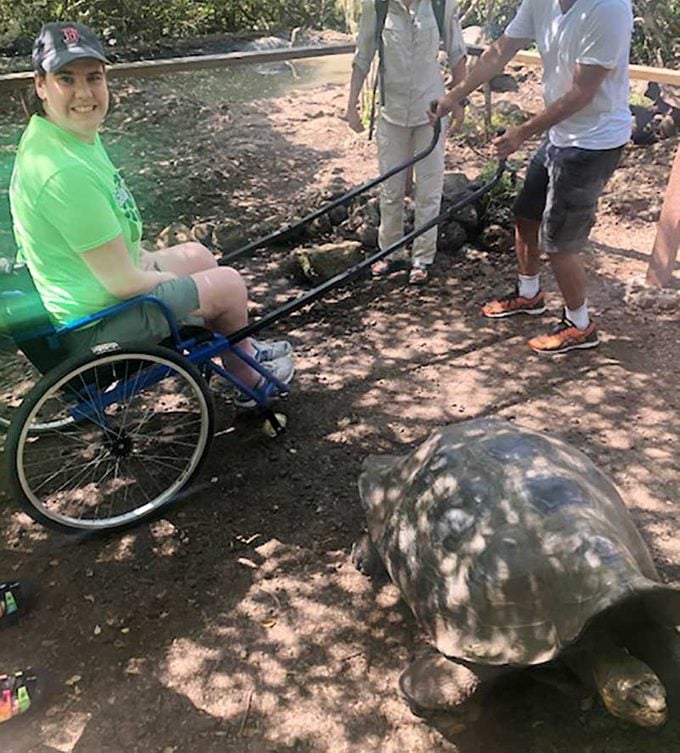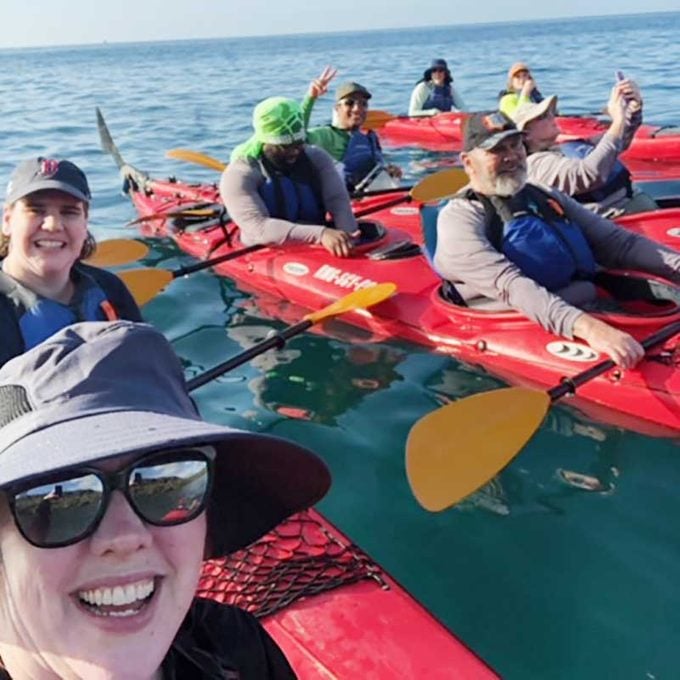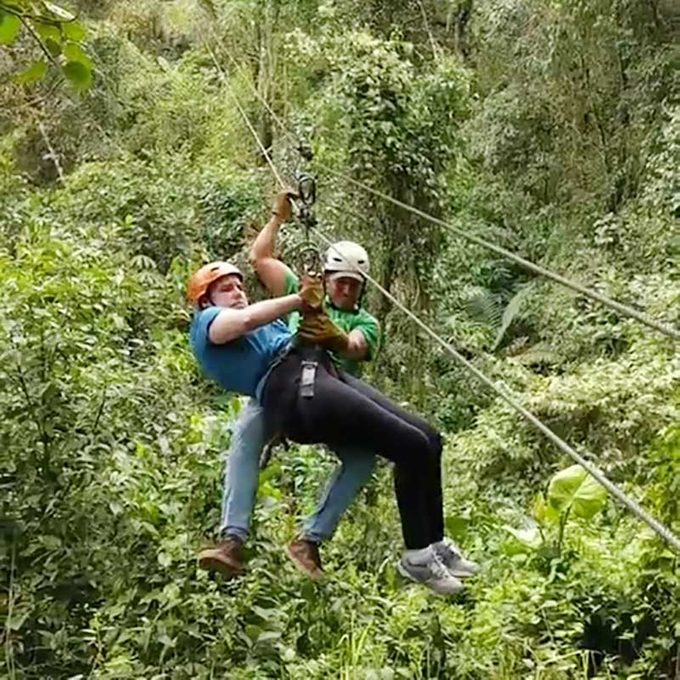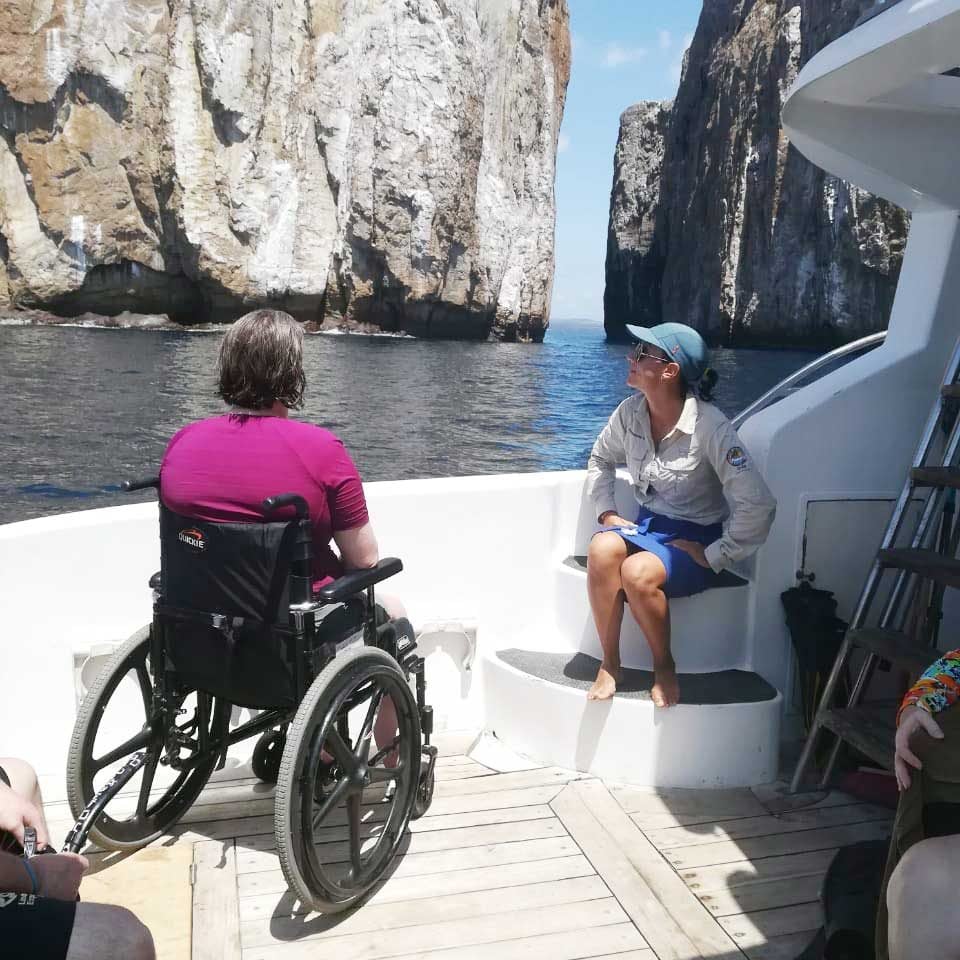From cacti and mangrove trees to giant turtles and amazing blue-footed boobies, some of the most diverse flora and fauna on Earth call the Galapagos Islands home. Best known as the place that inspired Charles Darwin’s theory of evolution, I have been fascinated by the islands since I was a child. However, I never thought the Galapagos Islands would be accessible to travelers with disabilities like me.
95% of the Galapagos Islands’ land area is protected by the Galapagos National Park Authority. Renowned for its natural beauty and untouched nature, navigating this place in a wheelchair seemed like a challenge. That’s why I was so excited when I found Latin America for All online. This sustainable and accessible tour company offers trips to Latin and South America for people with disabilities, and the Galapagos Islands were on their list of destinations.
We had never been on an accessible tour before, but the Galapagos Islands were amazing! It was a once in a lifetime trip that we just couldn’t miss. So in February 2020, our family of eight, ages ranging from 9 to 71, set off on the vacation of a lifetime.
Get more travel, tech, humor, cleaning, fun facts and more by subscribing to Reader’s Digest’s Read Up newsletter all week.
Travelling with a disability
 Courtesy of Elizabeth Dorman
Courtesy of Elizabeth Dorman
I have Charcot-Marie-Tooth disease, which affects the nerves in my arms and legs. It is one of the most common genetic neurological disorders, affecting 1 in 2,500 people in the United States.
Although I use crutches or a wheelchair to get around, that hasn’t stopped me from visiting countries like China, the UK, Ireland, Costa Rica, and I even travel several times a year for work. Traveling is a great way to learn more about the world around us.
That said, traveling with someone with a disability requires special consideration. You need to make sure your hotel has accessibility features, like step-free showers and grab bars in the bathroom. Even going out to a restaurant can be a challenge, especially if you encounter a place you have to climb stairs to get to. Plus, the definition of accessibility varies from country to country.
Before every trip, I do thorough research to see if the place I want to go to is wheelchair accessible. Some places are wheelchair accessible and some are not. The Galapagos Islands is not one of those places, so I was very happy to find a tour group that was customized for people like me. I learned a lot about wheelchair accessibility through this experience.
The right equipment is key
My wheelchair works fine on a variety of surfaces, but not on the sand. Luckily, our tour guide had a wheelchair specially designed for tough terrain.
The all-terrain wheelchair has two wheels instead of four and is pulled by two long handles at the front. This makes it easier to drive off-road and even get into the water. Once we got the wheelchair in the water, we were immediately floating and enjoying the waves.
On the first day of our trip, we went to La Loberia beach on San Cristobal Island, where we got to see sea lions and lava lizards up close and snorkel in the water. The beach is quite far from the center of San Cristobal Island, on a rocky stretch of sand, and without the special wheelchair, we would never have had the chance to see the sea lions playing and sunbathing.
On another day, we visited the Galapagos Tortoise Breeding Center. We learned about these prehistoric looking creatures and the efforts being made to protect them from habitat destruction and preying on invasive species. The center had special incubators for baby tortoises, but if you wanted to see adult tortoises in the wild, you had to go further afield.
I’ve always been fascinated by turtles, ever since I was a little girl, so seeing giant turtles in their natural environment was definitely at the top of my bucket list. With the help of a modified wheelchair and a strong helper, I was able to travel the entire length of the hiking trail, accomplishing another item on my bucket list.
It’s okay to acknowledge your limitations
 Courtesy of Elizabeth Dorman
Courtesy of Elizabeth Dorman
I’ll freely admit that I’m not good at accepting my limitations. I much prefer to push myself to the point of exhaustion rather than ask for help or admit that I can’t do something. This is part of why I’ve been so successful in life; I prefer to challenge expectations. At the same time, it’s not necessarily the healthiest habit, and it’s definitely made me sick as a result.
That’s why I was so proud of myself when I decided not to snorkel during a boat trip to Kicker Rock. The eroded cone of an extinct volcano rises 500 feet out of the Pacific Ocean, and the rock formation is one of the most famous snorkeling spots in the Galapagos Islands, where visitors can see sharks (both hammerheads and Galapagos sharks), manta rays, and sea turtles.
We loaded my wheelchair onto the boat and I went into the water for a bit to snorkel near the sea turtles. I would have regretted not doing so, but then I decided to stay. Was I sad to leave my family? A little. But as I sat on the boat looking out at Kicker Rock, I felt proud of myself for taking care of myself and admitting that I needed a break.
Plus, listening to my body meant I had enough energy left to kayak (and belt out “Moana”) with my family around San Cristobal Island the next day.
Accessible tour groups are a huge asset
 Courtesy of Elizabeth Dorman
Courtesy of Elizabeth Dorman
Booking an accessible travel guide with Latin America for All saved us time and worry. Instead of spending hours researching the Galapagos Islands and double- and triple-checking the accessibility of our planned activities, restaurants, transportation, and hotels, we were able to sit back, relax, and enjoy the trip of our dreams.
Traveling with an accessible tour company has other benefits too. Before we left, I knew I wanted to go ziplining with my family. I’d been lucky enough to zipline in my wheelchair on a previous trip, and I wanted to relive the exhilaration of soaring through the treetops.
This was a request my tour guide had received previously, so he was able to make it happen for us. Previously, both myself and my wheelchair were clipped to the rope. Our experience in Ecuador was different. My wheelchair was separately clipped to the rope while I zip-lined with the guide. As a bonus, my 9 year old nephew was finally old enough to stay with us.
Accessibility for all
Accessible tourism isn’t just for people with disabilities, but according to a 2022 report from MMGY Global, travelers with disabilities spend $58.2 billion a year on travel and take leisure trips just as frequently as people without mobility issues. It also benefits people who need a little extra help while traveling, such as seniors and people with small children.
As I often say, accessibility benefits everyone, and this not only applies to a Galapagos Islands vacation, but also to disability-friendly airlines and disability-friendly resorts.
And I can’t wait for the next adventure.
sauce:
MMGY Global: “Portraits of Travelers with Disabilities: Mobility and Accessibility”
Source link

